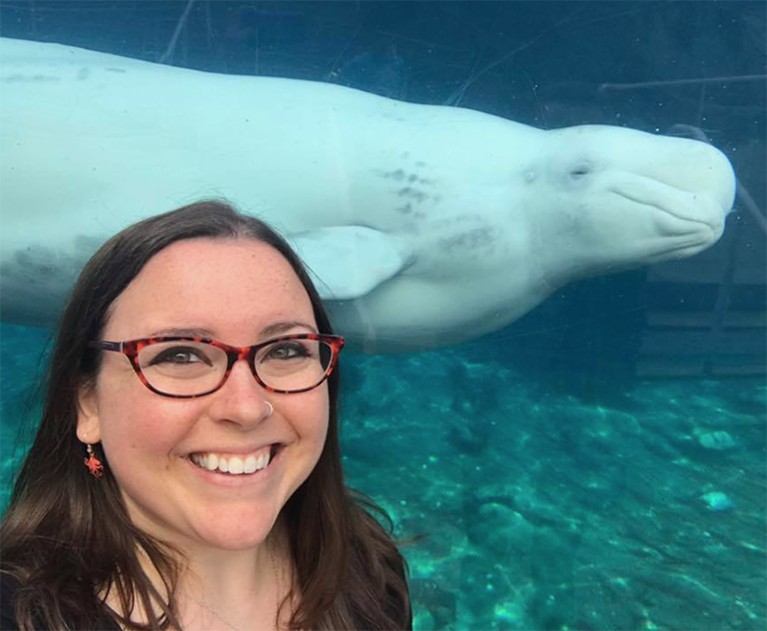
Biologist Sarah McAnulty in front of a beluga whale at a Connecticut aquarium.
Squid biologist Sarah McAnulty, a PhD student at the University of Connecticut in Storrs, launched Skype a Scientist in January 2017 to connect students, teachers and other groups around the world with scientists on every continent. The programme has linked more than 9,600 classrooms with 4,600 scientists from 43 countries.
Why did you create this programme?
Scientists on television and in movies are often depicted in a cold and calculating way. People think of us as data machines, and that’s so far from the truth. So I thought that if we could connect people with scientists, we could change that perception.
How does a session work?
The scientist will explain who they are and what they do, and allow time for questions and answers. We want it to be more of a conversation than a lecture — one of our main goals is to reach children whose schools might not have strong science programmes. And we wanted it to be free for participants, because we don’t want to serve only schools that have available funding. So far, we have signed up schools and colleges that cater for ages from 6 to university level. We’ve also done sessions for adults through library groups and book clubs.
What feedback have you received?
Scientists say that it’s a highlight of their day. We’ve had e-mails from teachers saying it has increased their students’ attentiveness in science. My colleague Mauri Liberati, a PhD student in natural resources who is also at the University of Connecticut, did 7 sessions in 2017 at a middle school for ages 11–14 in Los Fresnos, Texas. She talked to one class four times.
How did you first match classrooms with scientists?
I started the programme using a Google document that I linked to on Twitter and Tumblr, calling for scientists and teachers and asking for information about their locations, availability and interests. I tweeted about it constantly and asked others to share it on Twitter as well. I then matched respondents on the basis of their location, the type of scientist the teacher or group leader requested, and the types of scientist that we had available. It was like doing a humongous puzzle.
Do you classify scientists by speciality?
Yes. We started out with 20 science categories and have expanded to 28, from marine biology to computer science. The teachers were generally very happy with the categories, but requested to speak to astronauts much more frequently than we actually had astronauts available. We didn’t allow super-specific categories, because the more there were, the harder matching would be. I manually matched the first 800 sessions. Since then, we have used a computer algorithm.
Where did you get the algorithm?
It was built by bioinformatician David Jenkins, my best friend since high school, who is a PhD student at Boston University in Massachusetts. It runs great.
What’s next?
Increased enrolment: 9,600 classrooms in less than two years is great, but I know that we can get more. The positive feedback we have had is a good quantitative read-out of success.
Do you have a communications background?
I’ve always been active on digital platforms. In my first year of graduate school in 2014, I started a blog about squid on Tumblr. These animals are breathtaking in the complexity of their behaviour and general physiology, and I like to share that.
Will you pursue your interest in sharing information?
When I graduate, I will probably look into a science-communication career. I have filed paperwork to turn Skype a Scientist into a non-profit organization in Connecticut, and I am trying to raise US$100,000 through grants and crowdfunding to support my salary and advertising. It takes time to run the programme, and if I had a separate full-time job, it might be hard to do both. I am passionate about helping scientists to make connections outside their academic communities.

 Science for all: supporting diversity through science outreach
Science for all: supporting diversity through science outreach
 Outreach: Speak up for science
Outreach: Speak up for science




